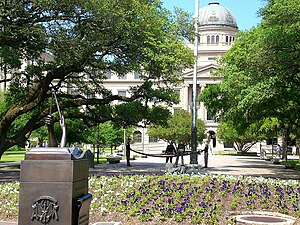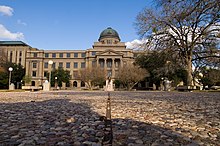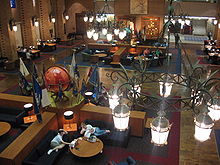Campus of Texas A&M University
[8] [9] Many people credit Texas A&M president Lawrence Sullivan Ross, known affectionately to students as "Sully", with saving the school from closure and transforming it into a respected military institution.
[10] Ross, the immediate past governor of Texas, had been a well-respected Confederate soldier along with being a Baylor graduate and he enjoyed a good reputation among state residents.
When students returned for the 1891–1892 school year, they found a new three–story, 41 room dormitory (named Ross Hall), the beginning of construction on a new home for the president, and a new building to house the machine and blacksmith shops.
[11] Enrollment continued to rise, so much so that by the end of his tenure Ross requested that parents first communicate with his office before sending their sons to the school.
Former students lived and studied in cramped, cheaply built and already-dilapidated WWII buildings without heating, air conditioning or indoor plumbing, and described having to hitchhike to and from the remote site if they did not have their own cars.
[19][20] The USAF fully vacated the base in May 1961 and the land and buildings were leased to Texas A&M in 1962 under an arrangement that would allow the university to buy the property at a heavily discounted price in the future.
[21] The George Bush Presidential Library was established in 1997 on 90 acres (36 ha) of land donated by Texas A&M at the western edge of the campus.
[22] In 1998, activists on campus (including Professor Patrick Slattery) suggested the statue of Lawrence Sullivan Ross should be removed on the basis that he was a member of the Ku Klux Klan.
The plan created by the architectural firm Barnes Gromatzky Kosarek Architects with Michael Dennis & Associates, was completed in July 2004.
In 2007, the Texas A&M University system had close to 700 million dollars of construction projects planned or already underway in the Bryan College Station area.
[35] In addition to academic facilities, athletics director Bill Byrne has overseen an aggressive expansion of the university's sports faculties since his hiring in 2003.
[41] In 2016, the facility was renamed RELLIS - an acronym of Texas A&M’s core values of respect, excellence, leadership, loyalty, integrity and selfless service.
[42] The 1,900-acre (8 km2) RELLIS hosts three training divisions of the Texas Engineering Extension Service (TEEX), which occupies about 100,000 square feet (10,000 m2) of offices, classrooms, and laboratories.
Classrooms in the new facility include interactive Smart boards, custom-built workbenches and cabinets, built-in audiovisual systems, and automatic lighting.
[47] The campus is also home to several Texas Transportation Institute (TTI) testing facilities used in the areas of vehicle performance and handling, vehicle-roadway interaction, the durability and efficacy of highway pavements, and the safety of structural systems.
Bush Combat Development Complex is a military research center on the RELLIS Campus, part of the United States Army Futures Command.
[54] The complex is also home to the Research Integration Center; Innovation Proving Ground; and Ballistic, Aero-optics and Materials Range, where weapons are tested.
[70] Gardens at University Apartments is zoned to the College Station Independent School District, which educates dependent children who live in them.
Housing the departments of geography, atmospheric sciences, and oceanography, it maintains a TTVN site for distance education which facilitates teaching with the Texas A&M University at Galveston campus.
The Music Programs were moved out and into a new multimillion-dollar facility (The John D. White '70 - Robert L. Walker '58 Music Activities Center) in the Fall of 2019, it includes an indoor marching hall design for the Fightin' Texas Aggie Band and a two Smaller Halls for the Concert Bands, Orchestras, and Choirs as well as numerous well insulated individual practice room.
Giesecke, features of this monumental classical structure include intricate Ionic columns, polished brass handrails along its marble staircases and stained-glass windows.
In 1997, the building was officially named after former Texas A&M University president Jack Williams to honor his work in increasing enrollment while preserving the traditional aura of the campus.
In the fall of 1904, Edwin Jackson Kyle, professor of horticulture and an 1899 graduate of Texas A&M, fenced off a section of the southeast corner of campus that had been assigned to him for agricultural use.
Using $650 of his own money, he purchased the covered grandstand from the Bryan fairgrounds and built wooden bleachers to raise the seating capacity to 500 people.
[91] Over the years, the modest wooden bleachers were expanded to a three deck concrete stadium with a capacity of 83,002, the second largest football venue in Texas.
Other features of the stadium and surrounding area include the Bright Football Complex, a natural grass field,[93] the Texas A&M Sports Museum, a press box, and the second largest video board in college athletics.
CBS Sportsline listed Kyle Field as the nation's top stadiums with a top-ranked score in three categories (atmosphere, tradition, and fans).
Additionally, the MSC contains many meeting rooms and is the home of numerous student committees "that provide an array of educational, cultural, recreational and entertainment programs for the Texas A&M community.
[58] Faculty, staff, and visitors may also take advantage of the on-campus shuttle route system, which operates from 7 am to 6 pm on weekdays, and at select times during nights and weekends.
It has six academic colleges in different places across Texas: Other components include the Institute of Biosciences and Technology at Houston and the Coastal Bend Health Education Center.

















